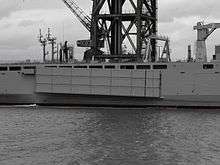Mexeflote
The Mexeflote is a landing raft used by the British Royal Logistic Corps and the Royal Australian Navy to move goods and vehicles between ship and shore. It was first used by British military in the 1960s. It was used during the Falklands conflict, and has been used in humanitarian aid missions. The system is very similar to the Rhino ferry.
| Mexeflote | |
|---|---|
A Mexeflote raft operating in the Solent | |
| Type | Landing raft |
| Place of origin | |
| Specifications | |
| Length | Standard: 20.12 m (66.0 ft) Maxi: 38.41 m (126.0 ft) |
| Width | Standard: 7.42 m (24.3 ft) Maxi 12.20 m (40.0 ft) |
| Crew | 6 |
| Engine | 2 x Hydromaster 6cyl diesel at 75 hp each or 2x Thrustmaster OD150N Propulsion Units 150 hp combined |
| Payload capacity | Standard: 60,000 kg (130,000 lb) Larger: 120,000 kg (260,000 lb) Largest: 180,000 kg (400,000 lb) |
History
The Mexeflote was introduced to the British military in the 1960s,[1] and it subsequently saw service in the Falklands War, in which three units were used,[2] including in Southampton, where they were used in loading the Royal Fleet Auxiliary and British Navy ships going to the Falklands.[3]
In 1994, the Army ordered an additional 50 units, and in 2000 they upgraded 60 of the rafts.[1] The Mexeflote was used during the 2010 Haiti earthquake, to transport supplies to the remote Haitian village of Anse-à-Veau from RFA Largs Bay.[4]

Currently the rafts are manned by the Royal Logistic Corps and they are largely used by the Royal Fleet Auxiliary's Bay class landing ships.[2] As part of the Royal Australian Navy's acquisition of the Bay class ship RFA Largs Bay (renamed HMAS Choules for Australian service), two Mexeflotes were also acquired.[5]
Design
Mexeflote is a powered raft (two diesel engines), used to move goods and vehicles between ship and shore when a pier is not available.[6] The Mexeflote is designed in three sizes;
| Type | Length | Width | Capacity | Ref |
|---|---|---|---|---|
| Standard size | 20.12 m (66.0 ft) | 7.32 m (24.0 ft) | 60,000 kg (130,000 lb) | [7] |
| Larger versions (Maxi-Mexeflote)[1] | 38.41 m (126.0 ft) | 7.32 m (24.0 ft) | 120,000 kg (260,000 lb) | [7] |
| 38.41 m (126.0 ft) | 12.2 m (40 ft) | 180,000 kg (400,000 lb) | [7] |
Each version has three components; bow, stern, and centre, which can be fitted together as required, making the Mexeflote a versatile craft.[6][8] The different sections allow it to be used as a raft, a floating pontoon, or as a causeway from ship to shore.[1]
Mexeflote was the basis for the design of the Modular Elevated Causeway.[9]
References
- "Tactical floating bridges and ferries", Jane's Military Vehicles and Logistics, Jane's, 27 April 2009, retrieved 18 May 2010
- "The Landing Ships and Landing Craft". www.britains-smallwars.com. Archived from the original on 11 December 2009. Retrieved 24 March 2010.
- Puddefoot, Geoff (2009). The Fourth Force. Major Robin H G Barton, MBE. Appendix 4: Seaforth. ISBN 1-84832-046-9.CS1 maint: location (link)
- "RFA Largs Bay delivers aid to isolated Haitian village". www.mod.uk. Retrieved 24 March 2010.
-
- "HMAS Choules commissioned". News. Royal Australian Navy. Archived from the original on 30 August 2012. Retrieved 21 December 2013.
- "Mexeflote Raft". www.army.mod.uk. Archived from the original on 8 April 2009. Retrieved 24 March 2010.
- "Landing Craft and Assault Boats; Mexeflote". www.army.mod.uk. Archived from the original on 27 December 2004. Retrieved 18 May 2010.
- "What is a Mexeflote". www.thinkdefence.co.uk. Retrieved 24 March 2010.
- "Modular Causeway Systems". www.globalsecurity.org. Retrieved 24 March 2010.
Further reading
| Wikimedia Commons has media related to Mexeflote. |
- Operational Testing of the Mexeflote Lashing and Launching System for Pontoon Causeways. - August 1970. Billie R. Karrh; James J. Traffalis; Naval Civil Engineering Lab.